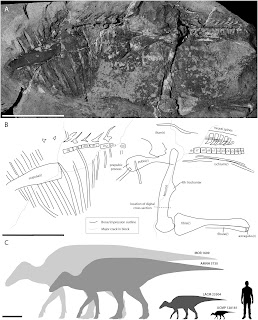Genesis 7:12
"Paleontologists recently discovered the partial fossils of two newspecies of dinosaur just outside of Casablanca. As stated in a Science Direct article, they “report two new abelisaurid fossils from the upper Maastrichtian phosphates of the Ouled Abdoun Basin, in northern Morocco.”
The University of Bath, England, press release stated:
Both were part of a family of primitive carnivorous dinosaurs known as abelisaurs [a family of ceratosaurian theropod dinosaurs], and lived alongside the much larger abelisaur Chenanisaurus barbaricus, showing that Morocco was home to diverse dinosaur species just before a giant asteroid struck at the end of the Cretaceous, ending the age of dinosaurs.
Creationists are happy that evolutionists are coming around and seeing that such a sudden burial is the result of a worldwidecatastrophe. However, this burial wasn’t the result of an asteroid, but of a worldwide flood about 4,500 years ago.
The Flood is hardly far-fetched. In fact, a parallel article inadvertently describes evidence of a water-based catastrophe. “Dr Nick Longrich, from the Milner Centre for Evolution at the University of Bath, led the study. He said: 'What’s surprising here is that these are marine beds.'"
Exactly. If these marine beds were the result of the Flood as described in Genesis, then one would not be surprised to find a mixing of terrestrial and oceanic animals.
The article continues, “It’s a shallow, tropical sea full of plesiosaurs, mosasaurs, and sharks. It’s not exactly a place you’d expect to find a lot of dinosaurs. But we’re finding them,” stated Longrich.
ICR’s Brian Thomas stated:
There is a distinct group of people on Earth today that are not surprised—at all—by the common pattern of finding dinosaur fossils in marine beds." ICR
ICR’s Brian Thomas stated:
But finding a mixture of fossilized marine and land creaturestogether is not an unusual occurrence. For example, the famous dinosaur beds in the Morrison Formation at Dinosaur National Monument contain logs, clams, snails, and mammals. And the Institute for Creation Research's front lobby features a juvenile hadrosaur taken from the Two Medicine Formationa sandstone formation which extends from the east side of the Rocky Mountains eastward to Edmonton, Canada—that was fossilized alongside marine clams and snails, as well as birds, mammals, and other dinosaurs.
There is a distinct group of people on Earth today that are not surprised—at all—by the common pattern of finding dinosaur fossils in marine beds." ICR


